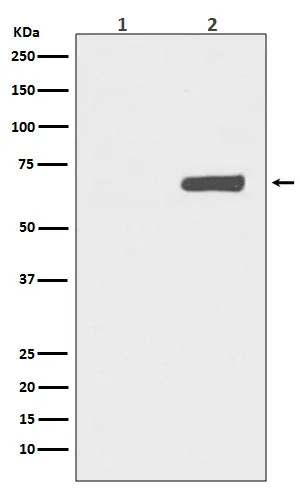
Size:100μL Price:$230
Size:200μL Price:$380
Application:WB,IHC
Reactivity:Human,Mouse,Rat
Conjugate:Unconjugated
Optional conjugates: Biotin, FITC (free of charge). See other 26 conjugates.
Gene Name:YAP1
Summary
| Production Name | Phospho-YAP1 (S127) (14M14) Rabbit Monoclonal Antibody |
| Description | Recombinant rabbit monoclonal antibody |
| Host | Rabbit |
| Application | WB,IHC |
| Reactivity | Human,Mouse,Rat |
Performance
| Conjugation | Unconjugated |
| Modification | Phosphorylated |
| Isotype | IgG |
| Clonality | Monoclonal |
| Form | Liquid |
| Storage | Store at 4°C short term. Aliquot and store at -20°C long term. Avoid freeze/thaw cycles. |
| Buffer | Rabbit IgG in phosphate buffered saline , pH 7.4, 150mM NaCl, 0.02% New type preservative N and 50% glycerol. Store at +4°C short term. Store at -20°C long term. Avoid freeze / thaw cycle. |
| Purification | Affinity purification |
Immunogen
| Gene Name | YAP1 |
| Alternative Names | 65 kDa Yes associated protein; YAP; YAp 1; YAP2; YAP 65;YKI; Yorkie homolog; |
| Gene ID | 10413 |
| SwissProt ID | P46937 |
Application
| Dilution Ratio | WB 1:1000-1:5000,IHC 1:100-1:200 |
| Molecular Weight | 54kDa |
Background
YAP (Yes-associated protein, YAP65) was identified based on its ability to associate with the SH3 domain of Yes. Transcriptional regulator which can act both as a coactivator and a corepressor and is the critical downstream regulatory target in the Hippo signaling pathway that plays a pivotal role in organ size control and tumor suppression by restricting proliferation and promoting apoptosis. Transcriptional regulator which can act both as a coactivator and a corepressor and is the critical downstream regulatory target in the Hippo signaling pathway that plays a pivotal role in organ size control and tumor suppression by restricting proliferation and promoting apoptosis (PubMed:17974916, PubMed:18280240, PubMed:18579750, PubMed:21364637, PubMed:30447097). The core of this pathway is composed of a kinase cascade wherein STK3/MST2 and STK4/MST1, in complex with its regulatory protein SAV1, phosphorylates and activates LATS1/2 in complex with its regulatory protein MOB1, which in turn phosphorylates and inactivates YAP1 oncoprotein and WWTR1/TAZ (PubMed:18158288). Plays a key role in tissue tension and 3D tissue shape by regulating cortical actomyosin network formation. Acts via ARHGAP18, a Rho GTPase activating protein that suppresses F-actin polymerization (PubMed:25778702). Plays a key role in controlling cell proliferation in response to cell contact. Phosphorylation of YAP1 by LATS1/2 inhibits its translocation into the nucleus to regulate cellular genes important for cell proliferation, cell death, and cell migration (PubMed:18158288). The presence of TEAD transcription factors are required for it to stimulate gene expression, cell growth, anchorage- independent growth, and epithelial mesenchymal transition (EMT) induction (PubMed:18579750). Suppresses ciliogenesis via acting as a transcriptional corepressor of the TEAD4 target genes AURKA and PLK1 (PubMed:25849865). In conjunction with WWTR1, involved in the regulation of TGFB1-dependent SMAD2 and SMAD3 nuclear accumulation (By similarity).
Research Area
Signal Transduction
